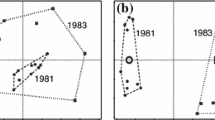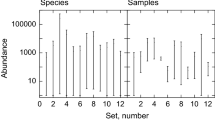Abstract
Gower's (1977) method for the canonical analysis of asymmetric matrices (CAA) where the same entities index both the rows and the columns is described. This technique displays the indexing entities in a series of orthogonal planes of decreasing importance in such a way as to preserve the pattern of the asymmetry between them. The analysis is applied to a half-diallel experiment and to some leaf-overtopping data, both from a study of the control of relative abundance of perennials in chalk grassland. The results suggest a common source for the asymmetry in the very different interference and overtopping data, namely that of leaf height. It is concluded that relative abundance in the field may be determined, in part, by leaf height through aboveground interference between plants.
Similar content being viewed by others
References
Eckart, C. & Young, G., 1936. The approximation of one matrix by another of lower rank. Psychometrika 1: 211–218.
Fowler, N., 1981. Competition and coexistence in a North Carolina grassland. II. The effects of the experimental removal of species. J. Ecol. 69: 843–854.
Gower, J. C., 1977. The analysis of asymmetry and orthogonality. In: J. Barra et al. (eds.), Recent Developments in Statistics, pp. 109–123. Amsterdam.
Greig-Smith, P., 1983. Quantitative Plant Ecology, 3rd ed. Blackwell Scientific Publications, Oxford.
Grubb, P. J., Kelly, D. & Mitchley, J., 1982. The control of relative abundance in communities of herbaceous plants. In: E. I. Newman (ed.), The Plant Community as a Working Mechanism, pp. 79–97. Blackwell Scientific Publications, Oxford.
Horn, H. S., 1975. Markovian processes of forest succession. In: M. L. Cody & J. M. Diamond (eds.), Ecology and Evolution of Communities, pp. 196–211. Harvard University Press.
McGilchrist, C. A. & Trenbath, B. R., 1971. A revised analysis of plant competition experiments. Biometrics 27: 659–671.
Mitchley, J., 1983. The Distribution and Control of the Relative Abundance of Perennials in Chalk Grassland. Ph.D. Thesis, University of Cambridge.
Pigott, C. D., 1968. Biological Flora of the British Isles: Cirsium acaulon (L.) Scop. J. Ecol. 56: 597–612.
Ratcliffe, D. (ed.), 1977. A Nature Conservation Review, Vol. 2. Cambridge University Press, Cambridge.
Silander, J. A. & Antonovics, J. 1982. Analysis of interspecific interactions in a coastal plant community—a perturbation approach. Nature 298: 557–560.
Sokal, R. R. & Rohlf, F. J., 1981. Biometry, 2nd ed. Freeman, San Francisco.
Turkington, R. & Harper, J. L., 1979. The growth, distribution and neighbour relationships of Trifolium repens in a permanent pasture. II. Inter- and intra-specific contact. J. Ecol. 67: 219–230.
Walker, D., 1970. Direction and rate in some British Post-glacial hydroseres. In: D. Walker & R. G. West (eds.), Studies in the Vegetational History of the British Isles, pp. 117–139. Cambridge University Press, Cambridge.
Author information
Authors and Affiliations
Additional information
Nomenclature follows Tutin et al., 1964–1980. Flora Europaea, Vols 1–5. Cambridge University Press, Cambridge.
I am particularly indebted to the Nature Conservancy Council for permission to carry out the field experiment on the Aston Rowant N.N.R., and to do field work at Castle Hill N.N.R.
We are grateful to R. A. Kempton for permission to use his methodology in the analysis of the half-diallel experiment prior to publication. This work was carried out while J.M. was in receipt of a Research Studentship from the Natural Environment Research Council, and L.G. was in receipt of an internal Research Studentship from Trinity College, Cambridge.
Rights and permissions
About this article
Cite this article
Mitchley, J., Guarino, L. Canonical analysis of asymmetric matrices: two applications from a study of chalk grassland in the south of England. Vegetatio 57, 53–60 (1984). https://doi.org/10.1007/BF00031930
Accepted:
Issue Date:
DOI: https://doi.org/10.1007/BF00031930




